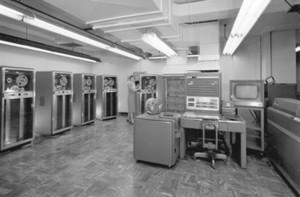Mainframe computer facts for kids
Mainframes are very powerful computers. People sometimes call them "big iron" because they are so large and strong. These computers are used for handling huge amounts of information. Governments and big businesses mainly use mainframes. They help with important tasks like counting populations (census) and tracking business numbers. Mainframes also manage company resources and handle many bank transactions every second. They are also special servers that help run the World Wide Web. Mainframes are different from supercomputers, which are used for very complex scientific calculations.
The word "mainframe" first described the large cabinets. These cabinets held the main parts of early computers. This included the computer's "brain" (the central processing unit) and its main memory. Later, the term helped tell the difference between these giant computers and smaller ones. These smaller computers were called "minicomputers" or "personal computers."
Contents
What are Mainframes?
Mainframes are built to be incredibly reliable. They can run for many years without stopping. They are also very secure, protecting important data. Mainframes can handle thousands of users and programs at the same time. This makes them perfect for big organizations. They can process billions of calculations every second. This high power means they can manage huge workloads.
Key Features of Mainframes
Mainframes have special features that make them unique.
- High Reliability: They are designed to almost never fail. This is important for things like banking systems.
- Scalability: They can easily grow to handle more work. You can add more power and memory as needed.
- Security: Mainframes have strong security features. This protects sensitive information from being stolen or lost.
- Centralized Control: They allow a single system to manage many different tasks. This simplifies complex operations.
- Legacy Support: Many mainframes still run very old but important programs. These programs are often too costly to rewrite for newer systems.
How Mainframes Are Used Today
Mainframes are still very important in our world. They power many services we use every day.
Handling Financial Transactions
Banks and financial companies rely heavily on mainframes. They process millions of credit card transactions daily. They also manage bank accounts and stock market trades. Mainframes ensure these transactions are fast, accurate, and secure. Without them, our financial systems would struggle.
Government and Public Services
Governments use mainframes for many tasks. They help with tax collection and managing social security benefits. They also support national databases and census data. This helps governments provide services to their citizens efficiently.
Enterprise Resource Planning (ERP)
Large companies use mainframes for ERP systems. These systems help manage all parts of a business. This includes inventory, human resources, and customer orders. Mainframes ensure all these different parts work together smoothly.
Cloud Computing and the Internet
Many cloud computing services use mainframes behind the scenes. They act as powerful servers for websites and online applications. When you access a big website or an online service, a mainframe might be doing the heavy lifting.
History of Mainframes
The first mainframes appeared in the 1950s. Early models like the IBM 701 were huge machines. They took up entire rooms. These early computers were very expensive. Only large organizations could afford them.
From Vacuum Tubes to Microchips
Early mainframes used vacuum tubes. These tubes were big and produced a lot of heat. Later, transistors replaced vacuum tubes. Transistors made computers smaller and faster. Today's mainframes use advanced microchips. These chips allow them to be incredibly powerful while taking up less space.
The Rise of Smaller Computers
In the 1970s and 1980s, smaller computers became popular. These included "minicomputers" and then "personal computers." Many people thought mainframes would disappear. However, mainframes adapted. They became even more specialized for their unique tasks. They continued to be essential for large-scale data processing.
Images for kids
See also
 In Spanish: Unidad central para niños
In Spanish: Unidad central para niños







